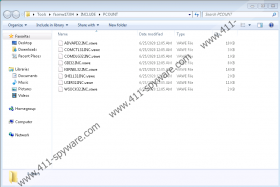Vawe Ransomware Removal Guide
Did Vawe Ransomware find a way into your system through a malicious downloader, a cleverly worded spam email, or perhaps an RDP backdoor? If you know how it slithered in, you might have a better chance of protecting your system against malware attacks in the future, and it might also be easier for you to locate and remove malware components. Unfortunately, even if you are able to delete Vawe Ransomware and watch out for certain types of attacks, that will not ensure that you will not face new infections in the future. It is imperative to have your operating system fully protected if you want to keep malware away, and this is something you must think about even if the decryption of your personal files is the topic that is currently occupying your brain. The ransomware encrypts files, after which they are basically lost. In most cases, the encrypted files cannot be salvaged, even if victims are willing to obey the demands of cybercriminals. However, we believe that there is a light at the end of the tunnel in this case.
If Vawe Ransomware is the infection that invaded your operating system, we can assure you that it is not the worst kind of file encryptor that you could have faced. There are file-encryptors that wipe data and make operating systems crash. There are also file-encryptors that are impossible to work with. Vawe Ransomware, however, is part of the infamous STOP Ransomware family (other members include Pykw Ransomware, Kasp Ransomware, or Odgo Ransomware). There is a free tool that cybersecurity experts built to help the victims of this malware. That said, it does not offer guaranteed decryption. However, because the tool is free, there is no harm in giving it a try. Perhaps you can decrypt all important files using it? Not many victims of ransomware are offered free decryptors, which is why we are hopeful. Of course, if a decryptor does not work, this malware is just as dangerous as any other. After encryption, all personal files should have the “.vawe” extension attached to them, and this is an indication that these files cannot be read or opened in a normal way.
What is the purpose of encryption? Normally, it is to secure important files. However, the attackers behind Vawe Ransomware have encrypted your files to make them inaccessible to you. That is meant to create a situation where the attackers can demand money from you. They are meant to convince you that you can obtain a decryptor for a certain price ($490). If you decide that you want to purchase the tool, you have to email the attackers first, and that is dangerous in itself. Of course, the first order of business is to provide you with the ransom payment instructions, but after that, the attackers could continue scamming and terrorizing you. Therefore, we do not recommend emailing the attackers, or at least, not using your usual email account. In general, we do not recommend exposing yourself to the cybercriminals in this way because you are unlikely to get a decryptor by paying the ransom. The attackers simply do not need to hold their end of the deal, and once your money is in their pocket, they can do whatever they want. Unfortunately, your money is likely to fund them and help them continue terrorizing other Windows users too. Of course, we do not recommend paying the ransom. We recommend deleting the infection.
It is easy for us to suggest removing Vawe Ransomware from the sidelines. However, you might feel torn if the encrypted files are important, if you do not have securely stored copies as replacements, and if you cannot use the free decryptor. Still, even if you end up losing all files, we do not recommend contacting and obeying cybercriminals. Of course, what you do is up to you. In any case, deleting Vawe Ransomware is crucial. While we have created a guide that should help remove this malware manually, we strongly advocate for implementing anti-malware software in this situation. Not only can this software locate and remove all malware components manually but also reestablish Windows protection. The attackers behind ransomware know all of the little cracks in Windows security, and they can use them to drop malware. And if your system was invaded once, it could be invaded again. Of course, if you implement reliable anti-malware software, the chances of malware slithering in again should be minimal if not non-existent.
How to delete Vawe Ransomware
- If you know where the {random name}.exe file that launched the infection is, Delete it.
- Tap Windows and E keys simultaneously to open the File Explorer window.
- Type %HOMEDRIVE% into the bar at the top and tap Enter to access the directory.
- Delete the file called _readme.txt and also the folder called SystemID.
- Type %LOCALAPPDATA% into the bar at the top and tap Enter to access the directory.
- If you can identify the {random name} folder that is part of the infection, Delete it.
- Empty Recycle Bin and then install a genuine malware scanner to help you scan the system.
Vawe Ransomware Screenshots:


